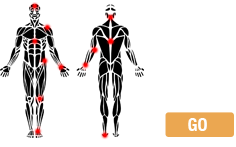Sciatica is a painful and highly misunderstood condition. Most people think it is a medical diagnosis on its own, but in fact sciatica is a symptom of some other problem in your body.
When someone suffers from sciatica the symptoms are clear. A sharp pain radiates along the sciatic nerve from the lower back down the buttocks, back of the leg, calf, and even down to the foot. It is a nagging and disruptive pain and it seems as though no position is helpful.
 Chronic lower back pain and sciatica pain can be accompanied by numbness and tingling in your leg, (paresthesia). Patients can experience muscle weakness and reflexes can be affected, but the pain is usually confined to one side only. Sciatica pain is worse while standing or sitting and can ease a bit when lying down or walking. Sciatica pain in both legs can be a sign of something more serious and should be addressed as soon as possible.
Chronic lower back pain and sciatica pain can be accompanied by numbness and tingling in your leg, (paresthesia). Patients can experience muscle weakness and reflexes can be affected, but the pain is usually confined to one side only. Sciatica pain is worse while standing or sitting and can ease a bit when lying down or walking. Sciatica pain in both legs can be a sign of something more serious and should be addressed as soon as possible.
Everyone experiences sciatic pain at different levels. The pain associated with sciatica can range from an inconvenient distraction or discomfort to a debilitating one. It can be described as moderate to excruciating.
The Real Causes of Sciatica
Sciatica is an irritation of the sciatica nerve producing pain in the nerves, buttock and leg. It can occur as a result of the compression of the spinal nerves (radiculopathy) in the lower lumbar region of the spine, or of the sciatic nerve in the buttock region known as Piriformis Syndrome.
The sciatic nerve is the widest and longest nerve in the body. It is located in the lower spine and its main job is to connect the spinal cord to our legs and foot muscles and transfer those sensory and motor signals between the lower body to our brain. It controls the muscles in the back of the knee and lower leg, and provides sensation to the back of your thighs, some parts of our legs and the soles of our feet.
As we age we inflict wear and tear on our spine. The components of our spine and back deteriorate slowly and what was once just normal aches and pain can suddenly become severe pain.
- Sciatic Nerve Impingement
The problem ensues when the sciatic nerve gets injured, irritated or compressed sometimes known as sciatic nerve impingement. This can occur when a disc in our lower back becomes herniated or ruptured. Our spinal bones (vertebrae) are separated by discs that cushion the spinal column. Discs allow movement between our vertebrae so we can easily bend and move. If a disc moves out of place or bulges it is referred to as herniated disc. This herniation and the resulting swelling or inflammation causes irritation and pressure on the sciatic nerve. If it breaks open completely it is a ruptured disc.
A bone spur, arthritis, or degeneration in your spine can narrow the space or hole (foramina) where the nerves pass and can contribute to nerve to impingement. In rare cases a tumor can also press on the sciatic nerve. This pinching of the sciatic nerve causes neuropathic symptoms like the pain described above. Our therapists will look for serious and subtle signs of neuropathic symptoms.
 The spinal nerves travel through small holes or tunnels called foramina. When these tunnels narrow it is called stenosis, and the narrowing can also lead to sciatica.
The spinal nerves travel through small holes or tunnels called foramina. When these tunnels narrow it is called stenosis, and the narrowing can also lead to sciatica.
This often is a degenerative problem which occurs over a long period of time. It can also happen suddenly due to excessive straining, lifting or an injury like a fall.
In turn there are other contributing factors in addition to age which can accelerate sciatica:
- Poor core stability
- Poor spinal control
- Deconditioning
- Being overweight
- Poor posture
- A job which require frequent bending and twisting, carrying heavy objects
- Participating in high impact sports
- Repetitive motions
- Staying in one position for long periods of time
- Diabetes, smoking
Treatments for Sciatica
Over the counter anti-inflammatory medications may help in the short term. Ice and heat are another way to get some relief. But unless the underlying source of the pain is treated, sciatica may return as a chronic condition. When you have tried all the other methods to no avail, you need the expertise and wisdom of professionals like those at PhysioActive Orthopaedic & Sports Injury Clinic.
Before our specialists at PhysioActive can initiate a treatment plan for your sciatica pain, we must determine where the nerve is impinged and why. Because it is the longest nerve in our bodies there are many places it can be irritated, often referred to as a Multi-Crush Syndrome. In this case the nerve is irritated in more than one location.
Every patient is different so you are best served by an individualized plan once we determine the exact cause of your sciatica pain. In many cases there will be a combination of treatments prescribed based on your diagnosis.
Your therapy leader will coordinate your care and decide which of the following specialty treatments are best for your specific problem.
Physiotherapy will help diagnose and manage your sciatica pain.
Massage therapy can accompany physiotherapy as a method to improve circulation which is beneficial for pain relief and recovery from injury.
Intra muscular stimulation or IMS helps to relax muscles and relieve musculoskeletal issues which can irritate the sciatic nerve. It can be one of the most effective permanent cures of neuropathic chronic nerve pain.
Osteopathy and manipulative therapy help normalize spinal movement and reduce irritation of your nerves as they travel through your back, buttock and leg.
Acupuncture may help to release the pain relieving endorphins in your body and give you some pain relief. Our specialists will use their knowledge of anatomy and neuro-physiology to choose the perfect treatment for your sciatica pain.
Schedule an Appointment Today
If you have reached for the anti-inflammatory pain medication all too often with little to no relief, or only temporary relief, it is time to face up your chronic sciatica pain. The specialists at PhysioActive will help determine the root cause of your pain, so don’t give up because we won’t.
Call us today at 905-695-0371 or fill out our simple request form. We are committed to discovering the solution to your pain. Our unique coordinated approach to care will provide the relief you or someone you know is looking for and help you begin enjoying life again without the pain of sciatica.


